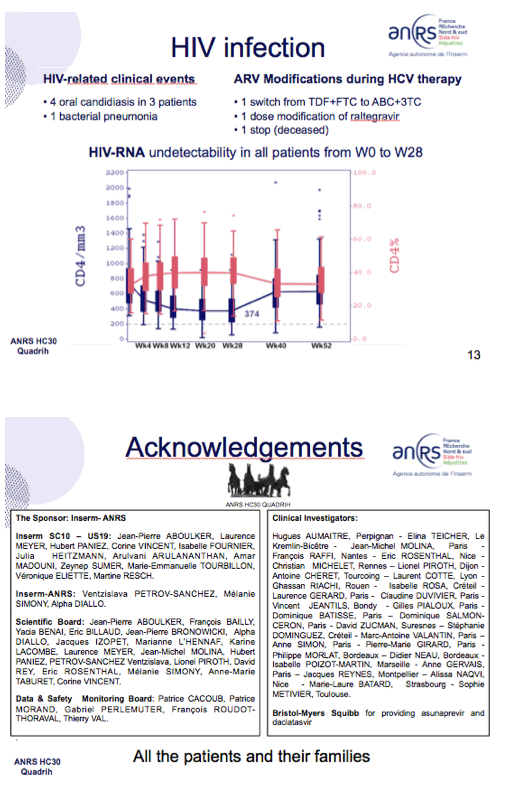 |
 |
 |
| |
SVR12 in over 90% of HCV/HIV null responders
stating daclatasvir/asunaprevir plus PR
|
| |
| |
CROI 2015, February 23-26, 2015, Seattle, Washington
Mark Mascolini
More than 90% of HCV/HIV-coinfected null responders to pegylated interferon/ribavirin (PR) had a sustained virologic response 12 weeks after the end of treatment (SVR12) with daclatasvir/asunaprevir plus PR in a single-arm ANRS trial [1]. Half of study participants had genotype 4 and one third had cirrhosis.
Lionel Piroth (University of Burgundy) and ANRS HC30 QUADRIH colleagues noted that HCV/HIV-coinfected people with HCV treatment experience have responded well to direct-acting antiretrovirals (DAAs). Because more information is needed about such patients, especially those with genotype 4 HCV or cirrhosis, they conducted this open-label single-arm phase 2 trial of daclatasvir/asunaprevir plus PR in PR null responders.
All study participants had HCV genotype 1 or 4, and all were taking a stable antiretroviral regimen for more than 1 month. All had an HIV load below 400 copies for at least 3 months, a CD4 count above 200, and a CD4 percent above 15%. The ANRS team aimed to enroll up to 50% of trial participants with compensated cirrhosis (greater than 14.5 kPa or F4 on liver biopsy).
Participants took PR for 4 weeks, then added 600 mg of daclatasvir daily and 100 mg of asunaprevir twice daily through week 28. The investigators calculated SVR12 (the primary endpoint) at week 40.
The ANRS team enrolled 75 people from January 2013 to June 2014, 27 of them (36%) with cirrhosis. Fifty-nine participants (79%) were men, and median age stood at 50 years (interquartile range [IQR] 48 to 53). Sixty-four people (85%) were taking raltegravir and tenofovir plus emtricitabine or lamivudine.
Sixty-nine people (92%) had an HIV load below 50 copies, and median CD4 count stood at 748 (IQR 481 to 930). A lower proportion of cirrhotics than noncirrhotics had an HIV load below 50 copies (81% versus 98%, P = 0.02). Median CD4 count was lower in cirrhotics than noncirrhotics (666 versus 776) but that difference was not significant (P = 0.58).
In the whole study group, median time since HCV diagnosis stood at 16 years (IQR 11 to 20), 49% has genotype 1 (45% 1a), and 51% had genotype 4. Median HCV load stood at 6.1 log (about 1.26 million IU/mL).
Among all study participants, 72 of 75 (96%) attained SVR12, including 35 of 37 (94.6%) with genotype 1 and 37 of 38 (97.4%) with genotype 4. Among people with cirrhosis, 25 of 27 (92.6%) attained SVR 12, including 13 of 14 (92.9%) with genotype 1 and 12 of 13 (92.3%) with genotype 4. Among people without cirrhosis, 47 of 48 (97.9%) reached SVR 12, including 22 of 23 with genotype 1 (95.7%) and all 25 with genotype 4.
Two people stopped treatment because of virologic breakthrough. Four others stopped treatment early, including 1 who died, 1 who stopped for cancer chemotherapy, and 2 who stopped because of infectious serious adverse events. All 3 survivors had undetectable HCV RNA at week 40.
Twenty-one people (28%) had serious adverse events, 11 of them (15%) hematologic. Twenty-six people (32%) had leukopenia and 24 (31%) had neutropenia. Twenty-six people (35%) used erythropoietin, 10 (13%) had a blood transfusion, 4 (5%) used leukocyte growth factor, and 1 (1%) used platelet growth factor.
Five HIV-related adverse events emerged--4 cases of oral candidiasis in 3 people and 1 bacterial pneumonia. One person changed the raltegravir dose and 1 switched from tenofovir/emtricitabine to abacavir/lamivudine. HIV RNA remained undetectable in all study participants from week 0 to week 28, and CD4 count or percent did not vary substantially through week 52.
The ANRS team concluded that this DAA combination "is an option in the therapeutic arsenal" and that it may be "of interest in a second-line or salvage approach."
webcast:
http://www.croiwebcasts.org/console/player/25803?mediaType=slideVideo&
Reference
1. Piroth L, Hubert Paniez H, Vincent C, et al. High efficacy of daclatasvir/asunaprevir/PR in HIV/HCV1-4 null responders (ANRS HC30). CROI 2015. February 23-26, 2015. Seattle, Washington. Abstract 146.
------------------------------
Reported by Jules Levin








|
| |
|
 |
 |
|
|